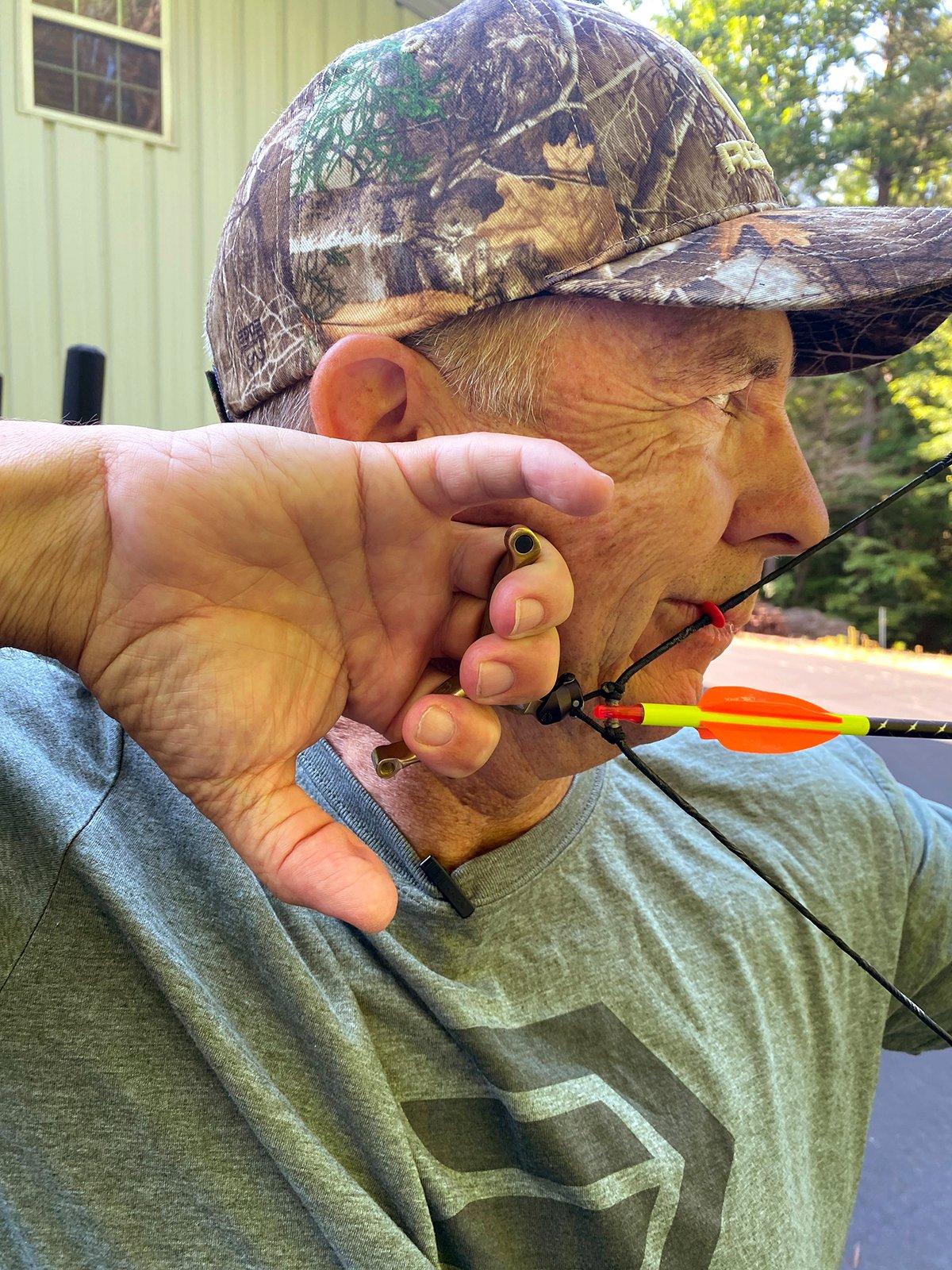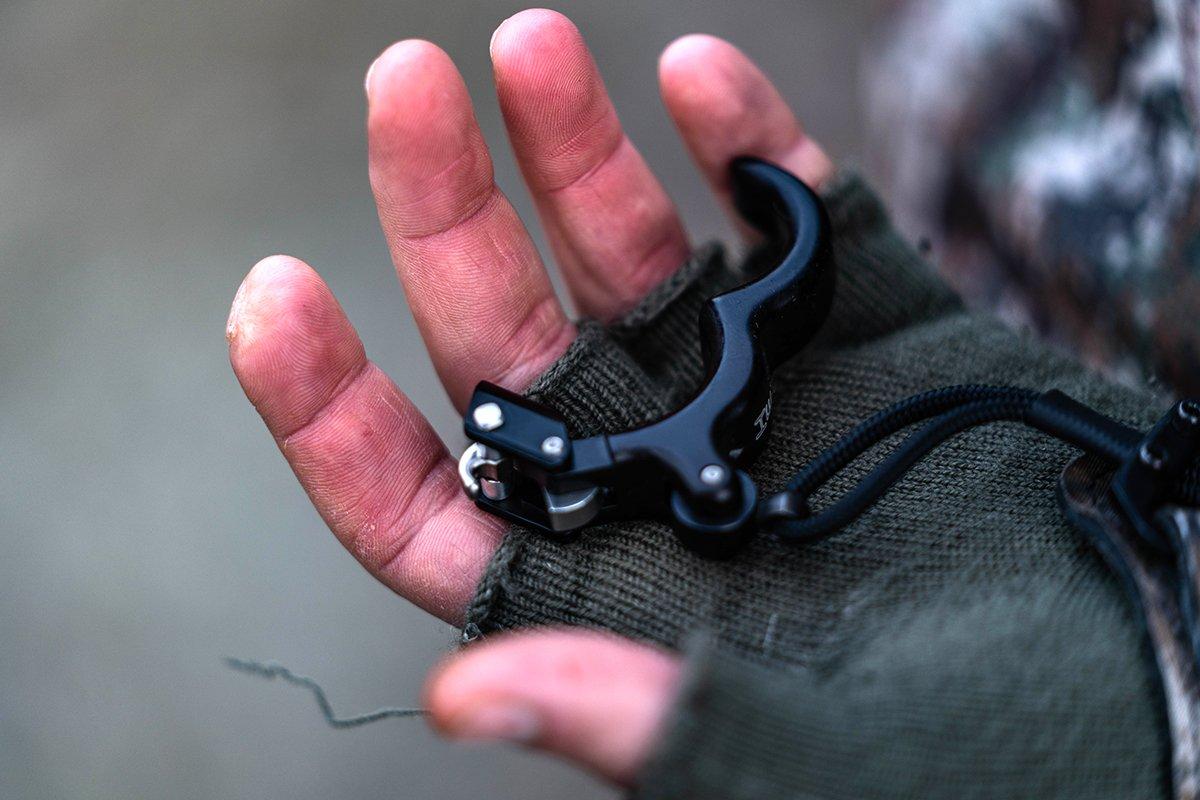With dedicated practice and a hinge-style release aid, Blanton is overcoming some bad bow-shooting habits that have crept in over the years. His routine might help you, too
David Blanton knew he had target panic. But like many bowhunters, the 46-year veteran of the deer woods and longtime host of Realtree Outdoors had always been able to manage it, like an annoying but otherwise harmless preexisting condition.
I've always been a puncher, Blanton says. I draw back, put the pin on the target, and punch the release. That's just the way I've always shot, and I've always been a pretty decent shot, too, especially under hunting conditions.
"You're going to have arrows launching into the wild blue yonder, not even close to the target."
But Blanton saw bad habits creeping into his shooting more than ever last summer, while he was practicing with his bow ahead of the 2020 season. I found myself anticipating when the pin would be on the target and trying to time punching my release with that. That's not a good situation to be in, he says. That's the beginning of more serious target panic.
(Don't Miss: The Best Draw Weight for Bowhunting)
Target panic affects most archers to one degree or another at some point. I've seen good bowhunters who fill tags every fall so afflicted that they could barely hit a block target at 20 yards in front of a crowd. I've suffered my bouts with it, too. For me, it manifests in a way that makes it difficult to raise my pin to the target, causing me to aim longer than I need to and leading to extra fatigue after fewer arrows. Like Blanton, I've managed to fight through it to this point, and I don't notice as much out hunting.
Blanton made it through the 2020 season with the usual ups and downs. He filled some tags, but he missed some shots too — and at the end of it, he just didn't have his usual confidence with his bow. In the past, Blanton had worked on his form in the offseason with the usual blank-bale shooting, where you step up close to a large target, close your eyes, and focus on a perfect shot sequence and good form. But that just wasn't enough. It got to the point where he felt anxiety upon picking up his bow, and that was a bad place to be. He knew he needed to change up aspects of his 2021 spring and summer practice routine and do something drastic to get back on course.
After consulting with some archery experts like Al Kraus, with Black Hills Archery, and Travis T-Bone Turner, Blanton decided to try a hinge release, in hopes of a start from scratch approach to his shooting form.
Many generically call that style of release a back-tension release, and though it is released with back tension, mechanical release aids can be released with back tension, too. Ideally you're shooting any release with back tension; that's the action, Turner says. But index-finger and thumb-break releases have a mechanical trigger that can be punched. A hinge does not.
When you graduate to a hinge, you're almost forced to use back tension because a hinge has no trigger, Turner says. Instead, the angle of the release hook on the D-loop pivots, or hinges, as the shooter executes the shot with slow back tension and pressure from the middle and ring fingers (and maybe the pinkie, too, depending on the release). When the hook finally rotates far enough that it slips off the D-loop, the result is a true surprise arrow. But there's a big learning curve to get there, and a few extra precautions to take. A back yard in town, near other homes and vehicles, is no place to try a hinge release for the first time.
(Killer Buy Alert: Realtree Camo Mesh Back Pro Staff Richardson Hat)
It was almost comical, learning to shoot it for the first time, Blanton says. You're going to have arrows launching into the wild blue yonder, not even close to the target. You've got to go through that to get comfortable. It's taken me weeks.
But he's getting there, and now the shot is a true surprise, allowing him to focus on a steady sight pin without anticipating a trigger punch. And that's what Blanton was after. He says he's shooting up to 200 arrows a day this summer — a volume of practice that he's never done.
Traditionally, because I've always been a puncher, I've always had this feeling that I would shoot my bow, make sure everything's in working order, that my pins are still on, and then I would shoot some. And I would shoot pretty good. But I wouldn't shoot a lot because in the back of my mind, the more I shot, the more bad habits I was likely to form, he says. With the hinge release, though, the more I shoot, the better I'll be. My shooting muscles are in good shape, too. Blanton is enjoying shooting his bow again, partly because he's not dreading making the mistakes.
Still, despite the hinge release's benefits for the range, it's not a practical choice for hunting. Just last fall, I heard a story of an antelope hunter who brought his hinge release to a water hole blind and accidentally launched an arrow out the window, before hitting full draw on a drinking pronghorn. In the field, you need the control of a trigger.
I won't hunt with a hinge release, Blanton says. The benefit of it is teaching my mind patience, so that when I pick up my thumb-activated hunting release, I execute a proper shot. About every 50 to 100 arrows, I grab my hunting release, and I shoot a group of four arrows. What's encouraged me and made me realize I'm on the road to recovery is that now, because of the shooting I've done with a hinge release, I'm holding that pin where I want it to hit, and before I know it the arrow is gone. It's a night-and-day difference in how much better I'm now shooting a hunting release.
(Don't Miss: 15 Archery Tips from the Pros)
Blanton says if you're having target panic, now is the time to address it with a drastic change-up, as he's doing. But he says to give yourself plenty of time, since it can take hundreds of arrows to even become comfortable with shooting a hinge release. This isn't something to try three weeks before hunting season, he says. But right now in the early summer, if you know you're having target panic issues, committing to a hinge release on the range can help. It's helped me.
For more details, check out the Realtree Outpost Podcast.









